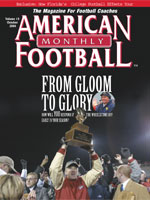AMERICAN FOOTBALL MONTHLY THE #1 RESOURCE FOR FOOTBALL COACHES
Article CategoriesAFM Magazine
|
The Use of Formations to Gain an Advantage© More from this issueGarrison High School has a long tradition of a winning football program. We have been in the playoffs 28 times and won 22 district championships. This was the first time in my coaching career that I had taken over a program that had a winning tradition and the opportunity was there to make a good program great instead of trying to turn an unsuccessful program into a winning program. I was hired in July of 1999 and had only a few weeks to familiarize myself with my coaches and players. I spent the time between mid-July and the beginning of practice in early August teaching the very basics of our offense and defense. The first season we learned everything on the run. We had a great season going 12-1 and getting beat in the third round of the playoffs. Subscribe today!
|
|
|||||||
| HOME |
MAGAZINE |
SUBSCRIBE | ONLINE COLUMNISTS | COACHING VIDEOS |
Copyright 2025, AmericanFootballMonthly.com
All Rights Reserved





